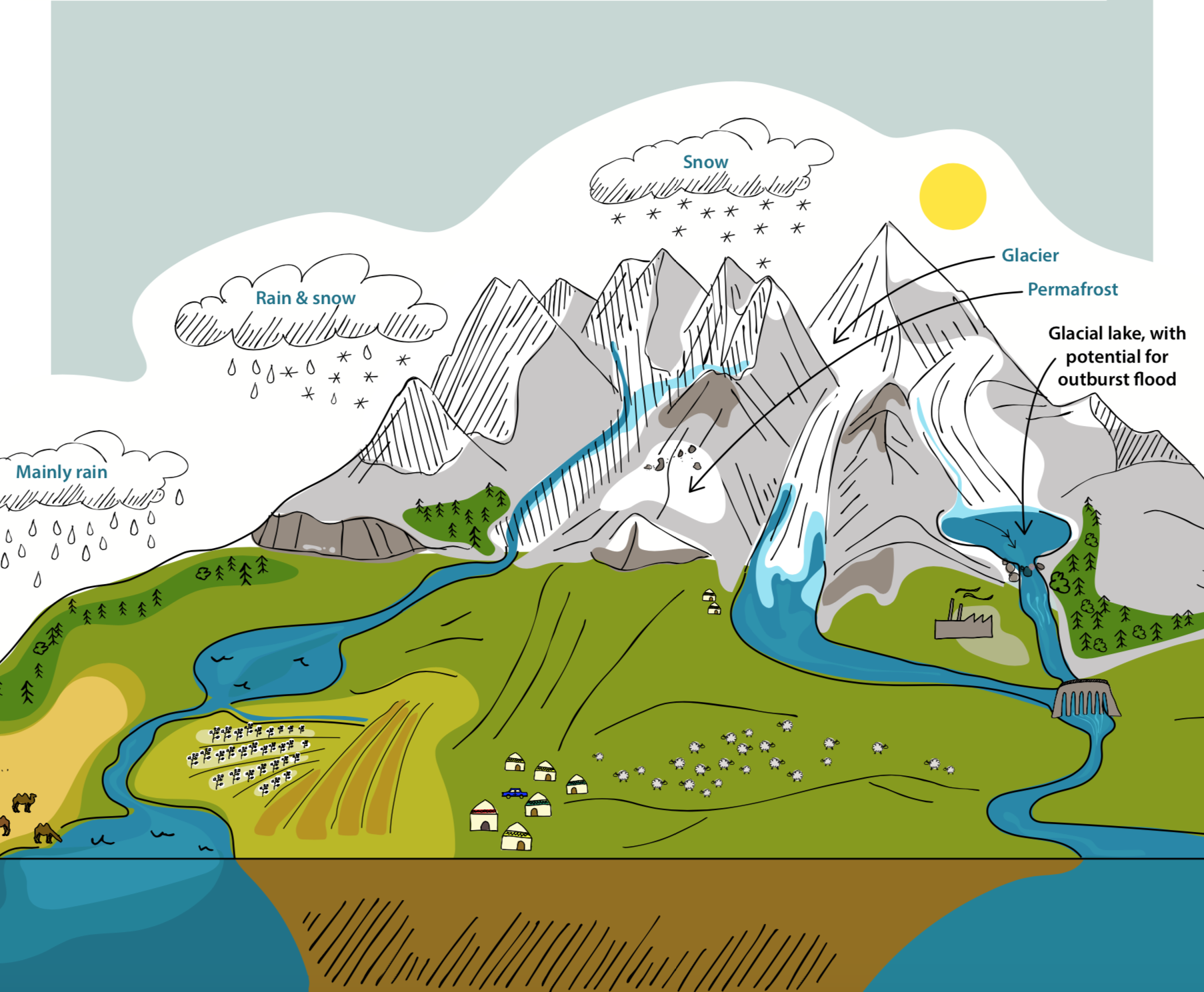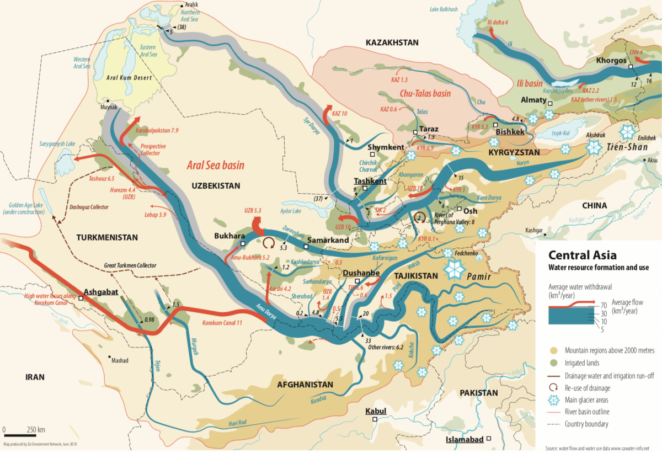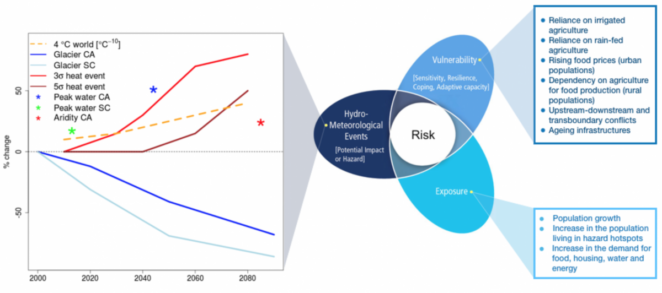Managing disaster risks and water under climate change in Central Asia and Caucasus

Introduction
Climate change is expected to have profound impacts on water resources and natural hazards in Central Asia and South Caucasus. This has serious implications for the management of water resources and natural hazards in both regions. This publication* is the result of a joint learning journey involving three thematic networks of the Swiss Agency for Development and Cooperation SDC – Climate Change and Environment, Disaster Risk Reduction, and Water – and interested SDC offices and partners. The basic idea was to create the opportunity for participants to address common challenges in a collaborative manner while focusing on a specific region or context.
This compilation presents the conclusions emerging from the discussions and the workshop, along with the three thematic input papers and the background paper. A Russian version of all materials will be made available shortly to ease the access for local partners based in Central Asia and the Caucasus.
The Thematic Input Papers contained in this publication:
- State of the knowledge on water resources and natural hazards under climate change in Central Asia and South Caucasus
- Actors, Approaches and Cooperation Related to Water Management and Natural Hazards under Climate Change in Central Asia and Caucasus
- Pathways to sustainable solutions for managing water and reducing disaster risks under climate change in Central Asia and Caucasus
There is also a Background Information Paper on ‘Sustainable water management and disaster risk reduction under climate change: Concepts, approaches and methods’.
*Download the full publication from the right-hand column. A summary of the key messages from the publication are provided below. See the full text for the Thematic Input Papers, case study examples and more detailed discussion. This publication is also available in Russian.

Key Messages
1. The impacts of climate change on natural hazards and water availability must be well understood, communicated and integrated into decision making and planning. Integration of scientific knowledge on the effects of climate change is a prerequisite for taking well-informed development decisions. Access to reliable and timely information is essential for effective natural resources management and for apprehending upcoming climate change challenges. In turn, the availability of such information requires the establishment of sound and reliable monitoring networks and information systems. Effective communication on potential solutions and their contribution to economic development is also fundamental.
2. DRR matters. Natural events can disrupt the environment, put communities at further risk, displace populations and destroy development achievements. Reducing disaster risks is necessary not just in order to save lives and livelihoods, but also to contribute to poverty alleviation, to sustainable development and to building resilience. A systematic approach to reducing risks of natural disasters should work to prevent disasters, to enable the effective management of disasters and to avoid creating new risks and vulnerabilities. This approach should include the assessment of all risks and corresponding hazards, including impact of climate change on the magnitude and frequency of hazards, and should provide for the evaluation of vulnerabilities and coping capacities. An in-depth assessment of all prevailing risks and their complex interconnectedness provides the basis on which to decide which risks to address.
3. A proactive approach to DRR and climate change is financially sound. Investments in DRR and climate change adaptation decrease the costs of catastrophic events and disaster recovery, improve community resilience and directly contribute to development. Communities, institutions and private entities at the local, national or regional level need to integrate DRR and climate change adaptation into their development and business plans.
4. Cross-sectoral and integrated approaches are needed. The issues related to agricultural practices, infrastructure, drinking water supply, sanitation and energy cross departmental lines, and require the collaboration of the agencies involved in water, energy, agriculture, housing and urban planning, and disaster management. Synergies across DRR, climate change and natural resource management should be harnessed and fostered through the adoption of integrated watershed management, ecosystem-based approaches, and integrated disaster risk management.
5. A culture of cooperation must be rebuilt. Central Asian countries and communities should recognize the potential of regional approaches and increased cooperation in finding mutually beneficial solutions to shared challenges. The region as a whole, the individual countries and specific communities may all benefit from the identification of entry points for cooperation, the facilitation of dialogue between technical experts and political leaders, and the reform and empowerment of existing institutions.
6. Local cross-border perspectives should be adopted. The resolution of local issues in water management, natural resource management and DRR often depend on regional and transboundary cooperation. At the same time, the resolution of regional issues may occur at the local level. Flexible local governance with strong public participation can be effective approaches in the search for solutions.
7. Existing technical innovations need to be used and disseminated. The region is host to pilot projects on efficient irrigation techniques, the selection of high-value, drought resistant crops that use less water, and techniques such as agroforestry and community pasture management to reverse soil degradation and increase groundwater recharge. These projects and their results need to be disseminated on a wider scale and supported by progressive policies and pricing mechanisms based on the true value of resources.
8. Private sector expansion can be part of the solution. Most water and natural resources management issues are the responsibility of the public sector. The limited role of the private sector in Central Asia can expand to include individual entrepreneurs acting as pioneers in testing technical innovations and promoting cost-effective solutions.
9. Governance is key to climate change adaptation, integrated disaster risk management, and water management. Responding to climate and disaster risk challenges calls for collective action, adequate policy instruments and functioning institutions; for the use of local knowledge and the participation of communities in decision processes; and for the capacity to mobilise material and funding that go beyond local means. Hence, the role of governments is instrumental in:
- Mainstreaming DRR, climate change and integrated water resources management into policies and institutions
- Integrating urban resilience into urban development processes and strengthening organizational capacities of municipalities
- Harmonising data collection methods and knowledge and making it available to all concerned partners
- Building national capacities and investing in education and training
- Reforming governance processes for the effective implementation of existing treaties, policies and good practices, and for accountability
- Orienting the action of international partners towards the successful integration of climate change and disaster risk and water management

(0) Comments
There is no content